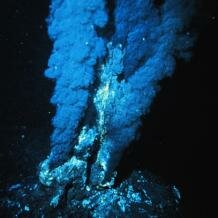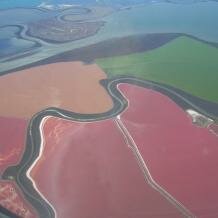Topic: Extremophiles: Archaea and Bacteria
Surely, no organism can survive in boiling water or brines nine times the salinity of seawater? Wrong - some archaea and bacteria have independently evolved adaptations to such extreme environments...
Microorganisms can colonise an extraordinary range of environments.  Most strikingly, some are able to survive very high temperatures (thermophiles), salinities (halophiles) and extreme pH levels (acido- and alkaliphiles). These so-called extremophiles have attracted wide interest, not only because of their remarkable physiological capacities and the potential biotechnological applications, but also because they may provide clues to the nature of extra-terrestrial life, on the widespread assumption that most planetary surfaces are far less benign than that of Earth.
Most strikingly, some are able to survive very high temperatures (thermophiles), salinities (halophiles) and extreme pH levels (acido- and alkaliphiles). These so-called extremophiles have attracted wide interest, not only because of their remarkable physiological capacities and the potential biotechnological applications, but also because they may provide clues to the nature of extra-terrestrial life, on the widespread assumption that most planetary surfaces are far less benign than that of Earth.
Extremophiles are often equated with the Archaea, a major group of microorganisms. Archaea used to be classed with bacteria as prokaryotes, but recent evidence has suggested that they constitute a separate domain, alongside bacteria and eukarya. Although the majority of extremophiles are indeed archaea, there are also extremophilic bacteria, which show striking convergences with their archaeal counterparts. Two key examples of this relate to the independent evolution of thermophiles and halophiles.
Thermophiles
 Geothermally heated regions, such as deep-sea hydrothermal vents or hot springs,
Geothermally heated regions, such as deep-sea hydrothermal vents or hot springs,  are amongst the most extreme environments on Earth. But still there is life – thermophilic microorganisms flourish in such conditions, some even in boiling water. Methanopyrus kandleri, which has recently been isolated from black smoker fluid in the Kairei hydrothermal vent, is the current record holder. This archaeon is able to survive a temperature of 122°C and correspondingly high pressure. More than 70 species of such hyperthermophiles, which have an optimum growth temperature above 80°C, have been described, since the first one (Sulfolobus acidocaldarius) was discovered in hot springs in the Yellowstone National Park in the early 1970s. And there are many other species that are moderately thermophilic, thriving at temperatures above 50°C.
are amongst the most extreme environments on Earth. But still there is life – thermophilic microorganisms flourish in such conditions, some even in boiling water. Methanopyrus kandleri, which has recently been isolated from black smoker fluid in the Kairei hydrothermal vent, is the current record holder. This archaeon is able to survive a temperature of 122°C and correspondingly high pressure. More than 70 species of such hyperthermophiles, which have an optimum growth temperature above 80°C, have been described, since the first one (Sulfolobus acidocaldarius) was discovered in hot springs in the Yellowstone National Park in the early 1970s. And there are many other species that are moderately thermophilic, thriving at temperatures above 50°C.
 Thermophily has evolved independently several times. Most thermophiles belong to the Archaea (e.g. Pyrolobus fumarii, Pyrococcus furiosus and Pyrobaculum aerophilum), but also many bacteria can tolerate very high temperatures (e.g. Thermotoga maritima, Thermus aquaticus and Aquifex aeolicus). Some molecular phylogenetic analyses suggest that these thermophilic bacteria represent an early evolutionary divergence. However, other bacterial thermophiles are evidently of more recent origin and, even though their phylogenetic position is not yet fully resolved, have most likely evolved independently.
Thermophily has evolved independently several times. Most thermophiles belong to the Archaea (e.g. Pyrolobus fumarii, Pyrococcus furiosus and Pyrobaculum aerophilum), but also many bacteria can tolerate very high temperatures (e.g. Thermotoga maritima, Thermus aquaticus and Aquifex aeolicus). Some molecular phylogenetic analyses suggest that these thermophilic bacteria represent an early evolutionary divergence. However, other bacterial thermophiles are evidently of more recent origin and, even though their phylogenetic position is not yet fully resolved, have most likely evolved independently.
Evidence for the convergence between thermophilic archaea and bacteria comes from the fact that they employ different mechanisms to achieve thermostability of their membranes and proteins. With respect to the cell membrane, there is no evidence for a single heat-tolerant lipid, rather thermostability seems to be related to the properties of the lipid bilayer. For lipid membranes to function effectively, a high permeability barrier and a liquid crystalline state are necessary. In archaeal membranes, isoprenoid hydrocarbon chains achieve these properties across the entire biological temperature range, so lipids do not need to be adapted to changing temperatures. The permeability of bacterial membranes, however, is temperature-dependent, so in order to achieve heat tolerance, they have to regulate their fatty acid composition.  Thermophiles also need to prevent the denaturating of their proteins, and here too, archaea and bacteria have come up with different solutions. Archaea seem to use a ‘structure-based’ mechanism, where increased compactness of the proteins results in their stabilisation. Here, disulfide bonding seems to play a major role. This is surprising, because it had long been assumed that disulfide bonds cannot persist in the reducing environment within cells and would therefore almost be exclusively extracellular. In contrast, thermophilic bacteria commonly employ a ‘sequence-based’ mechanism, where proteins are stabilised by changes in their amino acid sequence, which then allow the formation of additional salt bridges or other specific interactions. Both thermophilic archaea and bacteria furthermore accumulate some unusual compatible solutes, such as di-glycerol-phosphate, which might assist in thermoprotection of enzymes and proteins.
Thermophiles also need to prevent the denaturating of their proteins, and here too, archaea and bacteria have come up with different solutions. Archaea seem to use a ‘structure-based’ mechanism, where increased compactness of the proteins results in their stabilisation. Here, disulfide bonding seems to play a major role. This is surprising, because it had long been assumed that disulfide bonds cannot persist in the reducing environment within cells and would therefore almost be exclusively extracellular. In contrast, thermophilic bacteria commonly employ a ‘sequence-based’ mechanism, where proteins are stabilised by changes in their amino acid sequence, which then allow the formation of additional salt bridges or other specific interactions. Both thermophilic archaea and bacteria furthermore accumulate some unusual compatible solutes, such as di-glycerol-phosphate, which might assist in thermoprotection of enzymes and proteins.
Halophiles
 Hypersaline lakes, such as the Great Salt Lake in Utah, or salt ponds often show dramatic pink or red colouration. This is due to high densities of halophiles, whose cells contain high concentrations of pigments, which aid in the conversion of light into chemical energy or provide protection from radiation. These halophiles can tolerate very high salinities – some even flourish in brines totally saturated with salt (which equals nine times the salinity of seawater!). Halophiles do not only occur in natural habitats with high salt concentrations, but can also be involved in the fermentation of salty foods.
Hypersaline lakes, such as the Great Salt Lake in Utah, or salt ponds often show dramatic pink or red colouration. This is due to high densities of halophiles, whose cells contain high concentrations of pigments, which aid in the conversion of light into chemical energy or provide protection from radiation. These halophiles can tolerate very high salinities – some even flourish in brines totally saturated with salt (which equals nine times the salinity of seawater!). Halophiles do not only occur in natural habitats with high salt concentrations, but can also be involved in the fermentation of salty foods.
 As with thermophiles, there is a distinction between moderate halophiles, which show optimal growth in NaCl concentrations between 0.5 M and 2.5 M, and hyperhalophiles, which require NaCl concentrations higher than 2.5 M. Halophily is found in both archaea and bacteria. Examples of archaeal halophiles include Haloarcula, Haloferax, Halococcus and the rather confusingly named Halobacterium. Probably the best-known halophilic bacterium is Salinibacter ruber, which thrives in saltern crystalliser ponds, but there are other bacterial halophiles, such as Chromohalobacter beijerinckii, which was isolated from fermented salted beans, and Tetragenococcus halophilus, which is found in soy sauce and salted fish.
As with thermophiles, there is a distinction between moderate halophiles, which show optimal growth in NaCl concentrations between 0.5 M and 2.5 M, and hyperhalophiles, which require NaCl concentrations higher than 2.5 M. Halophily is found in both archaea and bacteria. Examples of archaeal halophiles include Haloarcula, Haloferax, Halococcus and the rather confusingly named Halobacterium. Probably the best-known halophilic bacterium is Salinibacter ruber, which thrives in saltern crystalliser ponds, but there are other bacterial halophiles, such as Chromohalobacter beijerinckii, which was isolated from fermented salted beans, and Tetragenococcus halophilus, which is found in soy sauce and salted fish.
Halophiles have evolved a number of adaptations to high salinity. The high external ion concentration necessitates internal osmotic adjustments so as to prevent damage. There seem to be two major strategies to increase the internal osmotic concentration. Many archaea and bacteria accumulate compatible solutes such as amino acids or sugars in their cytoplasm. These do not impair cell function and protect the cells from different kinds of stress (including temperature stress). The extremely halophilic archaea in the family Halobacteriaceae, the moderately halophilic bacteria in the order Halanaerobiales and S. ruber, however, have independently evolved a more radical adaptation. They rely on the selective influx of potassium ions from the environment, which can lead to extremely high salt concentrations in the cytoplasm. To accommodate these high internal salt concentrations and prevent the salting out of proteins, neutral amino acids have been replaced with acidic ones (especially aspartic acid). Other protein stability adaptations include low hydrophobicity and a coil rather than a helicoidal structure. Halophiles also seem to possess specific genomic signatures. As Sandip Paul and colleagues remark, “the generality of molecular signatures for environmental adaptation of extreme salt-loving organisms (…)  advocates the convergent evolution of halophilic species towards specific genome and amino acid composition, irrespective of their (…) widely disparate taxonomic positions. The adapted features of halophiles seem to be related to physical principles governing DNA and protein stability, in response to the extreme environmental conditions under which they thrive” (2008, Genome Biology, vol. 9, p. R70). Convergence is particularly striking between the haloarchaea and S. ruber, including molecular as well as physiological convergence. For example, the colonies of both haloarchaea and S. ruber are red due to the presence of carotenoids in the membrane, but the carotenoids employed are chemically different – C-50 bacterioruberins in the archaea and salinixanthin (a C-40 acyl glycoside carotenoid) in the bacterium. Interestingly, salinixanthin functions with another pigment in a light-harvesting complex that is very similar to the light-harvesting systems based on chlorophyll.
advocates the convergent evolution of halophilic species towards specific genome and amino acid composition, irrespective of their (…) widely disparate taxonomic positions. The adapted features of halophiles seem to be related to physical principles governing DNA and protein stability, in response to the extreme environmental conditions under which they thrive” (2008, Genome Biology, vol. 9, p. R70). Convergence is particularly striking between the haloarchaea and S. ruber, including molecular as well as physiological convergence. For example, the colonies of both haloarchaea and S. ruber are red due to the presence of carotenoids in the membrane, but the carotenoids employed are chemically different – C-50 bacterioruberins in the archaea and salinixanthin (a C-40 acyl glycoside carotenoid) in the bacterium. Interestingly, salinixanthin functions with another pigment in a light-harvesting complex that is very similar to the light-harvesting systems based on chlorophyll.
Cite this web page
Map of Life - "Extremophiles: Archaea and Bacteria"
https://mapoflife.org/topics/topic_354_extremophiles-archaea-and-bacteria/
March 3, 2021

